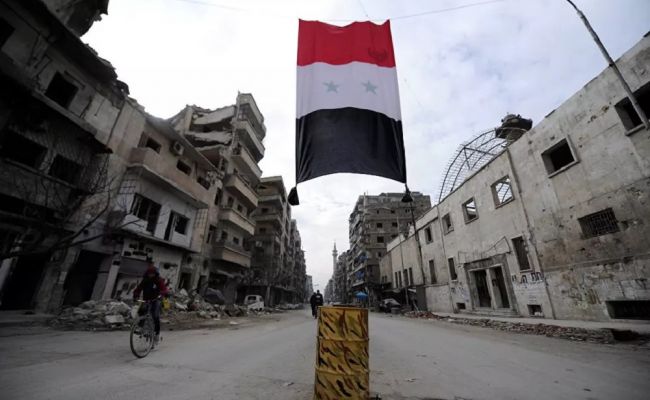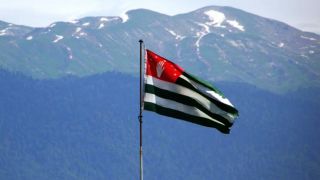On the heels of President Donald Trump’s “landmark visit” to Saudi Arabia, mainstream media in the largest Arab monarchy started disclosing confidential information, referring to well-informed high-ranking military and diplomatic officials, of course. A London-based pro-Saudi newspaper Asharq Al-Awsat wrote “US and Russian officials resume their military and diplomatic talks in Oman in the next few days with an aim to establish a “safe zone” southern Syria. (1) Reportedly, Moscow and Washington representatives agreed to resume talks to establish “safe zone” in Southern Syria after a similar dialogue had been suspended recently. (2)
The reason behind postponement of talks was the known air strike by the U.S.-led coalition against Daesh (“Islamic State,” IS, ISIL terrorist group) that targeted pro-governmental forces. On May 18, coalition warplanes hit a convoy of vehicles affiliated to the regime forces and Iran in the northwest of al-Tanf, Homs province.
Located over the intersection of the Syrian, Iraqi and Jordanian borders, Al-Tanf settlement has grabbed international attention lately. With the support of U.S. and British special forces (some sources mention also “Norwegian military instructors” deployed in al-Tanf), al-Tanf “houses” troops of the so-called “New Syrian Army” (NSA, since December 2016, it is called Jaysh Maghawir al-Thawra (The Revolutionary Commando Army)). Formally, “moderate” militants are trained by the Western special forces to fight ISIS terrorists. In fact, The Revolutionary Commando forces are prepared to deter Iran’s growing influence and its forces in Southern Syria. Meantime, borders of one of the De-Escalation Zones are to be determined by June 4 under the agreement signed by Russia, Iran and Turkey on May 4 in Astana.
This is where the most interesting part of the story starts. The three countries decided to mark the De-Escalation zones on maps by early next week and then start creating the zones in the trilateral format. If U.S. is not involved in the process, what will Russian and U.S. military and diplomats be discussing in Oman? According to Asharq Al-Awsat, Russia and U.S. will resume talks “to tackle the size of the safe zones, the local council, the monitors, human aids.” The source reports that Washington has set a condition to “reject the presence of the Iranian militia in the area stretching from al-Qunaytara in Gholan to Deraa, the countryside of Suweyda’ – reaching al-Tanf.””
Evidently, the condition is not feasible. Reports that Russia and U.S. will resume talks on southern De-Escalation zone look like information sabotage, an attempt to spoil the relations of Moscow and Tehran. The time for such information leaks has been chosen quite scrupulously as the Russian, Iranian and Turkish joint group is due to finish the safe zones mapping process.
U.S. and Saudi Arabia are concerned over the southern areas of Syria where military actions have not been in their favor lately. Iran is due to establish a permanent base in Damascus province. Iran’s leadership and military command announce plans to double the number of their “military advisors” in Southern Syria, which is troublesome for U.S., Saudi Arabia and Israel. Secretary of Iran’s Supreme of National Security Council Ali Shamkhani has announced such plans when travelling to Moscow recently.
It is logical that Tehran seeks permanent deployment in Syria, as Iranian forces are involved in de-escalation of “certain areas in Deraa and Quneitra provinces” (under May 4 memorandum signed in Astana). Israel will face serious challenges on its eastern borders, while Saudis may lose their last zone of influence in Eastern Ghouta controlled by Jaysh al-Islam (Army of Islam) group in Southern Syria.
The given area is marked as a separate de-escalation zone. However, the geographical location of the area and the status of a military and political enclave provide no guarantees to Riyadh-supported militants that will have to accept conditions of the pro-governmental troops and move to Idlib sooner or later. Syrian army and allied pro-Iranian groups are gradually making a ring around East Ghouta. These days, governmental troops are preparing to storm the last foothold of the Army of Islam, though so far it is a “developing attack” rather than large-scale military operation. (3)
Only drastic measures, even preventive air strikes, will help Iran’s regional rivals to change the situation in their favor. They have already made one on May 18 hitting a convoy of vehicles affiliated to the regime forces and threw it back to al-Tanf. Israel-U.S.-Saudi Arabia “tripartite alliance” hesitates to launch more attacks so far not to face Russia’s discontent and even a symmetric response.
Noteworthy is the fact that U.S. came out with a statement on behalf of the Inherent Resolve Combined Joint Task Force saying, “The coalition struck pro-regime forces that were advancing well inside an established de-confliction zone northwest of At Tanf, Syria, May 18, and that posed a threat to U.S. and partner forces at At Tanf. This action was taken after apparent Russian attempts to dissuade Syrian pro-regime movement south towards At Tanf were unsuccessful, a coalition aircraft show of force, and the firing of warning shots. Coalition forces have been operating in the At Tanf area for many months training and advising vetted partner forces engaged in the fight against ISIS.”
A question arises as to what “established de-confliction zone northwest of al-Tanf” they were speaking about, if that settlement is rather far from the southern regions mentioned in the tri-partite memorandum signed on May 4? Actually, U.S. inherently hinted that it would not weigh its further actions in Syria’s airspace against the de-escalation zones to be established by Russia, Iran, and Turkey. However, as soon as it faced an urgent need to explain its regular aggression against Syria’s government troops, it referred to the “established de-confliction zones” immediately.
Earlier, in mid-May, Washington cast doubts on success of ceasefire in Syria established under joint guarantees of Moscow, Tehran and Ankara. U.S. Secretary of State for the Near East Affairs Bureau Stuart Jones was quite skeptical about fruitfulness of the tri-partite efforts to set up de-escalation zones in Syria, not to mention the critical stand of Pentagon, Joint Chiefs of Staff and CIA. In such conditions, it is hard to anticipate any constructive talks between Russia and U.S. in Oman, if they take place at all. Washington is keen to get Moscow’s consent to share influence zones in Southern Syria. The previous White House Administration had already made a similar suggestion applicable to the same Homs province before. However, the Kremlin did not welcome that initiative of the U.S. Military Command under Barack Obama. Now, Donald Trump’s team has caught the idea.
Along with the efforts to “persuade Russians” to share influence zones, U.S. seeks to torpedo Tehran’s plans to set up its first military base in the worn-torn Syria. What the U.S. Administration seeks is “zones of influence” and not “safe zones.” Israel and Saudi Arabia support U.S. in that process. That is why Trump’s “landmark visit” to those countries prompted deliberate information leaks by the Middle East media. Ahead of Saudi Arabia king’s visit to Moscow, media will be flooded with “generous proposals” to the Kremlin on Syria.
(1) Ibrahim Homeidi, US Acts to Infiltrate the ‘Iranian Crescent' // Asharq Al-Awsat, 29.05.2017.
(2) Russia, U.S. and Jordan negotiate to establish safe zones in the south of Syria. Al Arabiya learned this information in late May from a source “close to the talks.” No more details are reported.
(3) Republican Guard of Syrian Armed Forces and National Defense Forces with the support of Palestine Liberation Army resumed offensive operation in Eastern Ghouta on May 29. The government troops attacked Jaysh al-Islam positions near Hosh al-Duara area. During the military actions, the Syrian military and Palestinian rebels managed to advance into the southern and northern districts of the given area.
EADaily’s Middle East Bureau


 Rubio fears that Kiev will return to tough negotiating positions — Reuters
Rubio fears that Kiev will return to tough negotiating positions — Reuters Following Rubio, the foreign ministers of France and Germany will not go to London
Following Rubio, the foreign ministers of France and Germany will not go to London Rubio changed his mind about going to London after Zelensky's refusal to recognize Crimea as Russian — NYT
Rubio changed his mind about going to London after Zelensky's refusal to recognize Crimea as Russian — NYT A general of the Rosgvardiya was detained in Moscow
A general of the Rosgvardiya was detained in Moscow The Ministry of Defense called the cause of the emergency in the Vladimir region
The Ministry of Defense called the cause of the emergency in the Vladimir region London and Kiev are preparing a provocation to disrupt the peace process on Ukraine — insider
London and Kiev are preparing a provocation to disrupt the peace process on Ukraine — insider